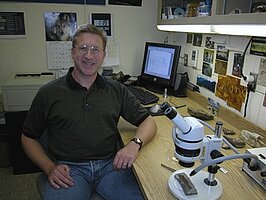Comparative Study of Fossil and Extant Fish Growth: Including Analyses of Mean Annual Temperature in the Geologic Record

Michael Newbrey's general research interests include freshwater teleost systematics, biogeography, and paleoecology for both extant and extinct fish. In the past, his research focus has been on the osteoglossids and esocids, but is now including other taxa in the dissertation research. He has a Bachelor's degree in Biology with Fisheries and Limnology (1998) and a Masters degree in Natural Resources (2002) both from the University of Wisconsin at Stevens Point. For his M.S. degree, he studied the morphology of submerged trees and fish cribs as fish habitat in Katherine Lake of northern Wisconsin.
Fellow: Michael Newbrey, Department of Biological Sciences, NDSU
Advisor: Allan Ashworth, Professor of Geology, Department of Geosciences, NDSU
Matching Support: NDSU
Degree Progress: Ph.D. expected in December 2006.
Comparative Study of Fossil and Extant Fish Growth: Including Analyses of Mean Annual Temperature in the Geologic Record
Very little is known about growth and the life history characteristics of fish in the fossil record. Fossils can provide valuable information about growth of extinct forms of fish, thereby providing insight into their life histories and ecology.

Project objectives:
My project entails an examination of the relationships between age, growth, longevity, and climate on a geologic scale. The objectives of the study are to: 1) examine the age and growth patterns of fossil freshwater amiids, hiodontids, esocids, and the percid, Perca flavescens from all fossil localities known to produce these taxa in North America; 2) investigate evolutionary and geographic patterns occurring in the geologic record to understand the effects of climate change on fish; 3) quantify patterns of growth of extant amiids, hiodontids, esocids, and the percid, Perca flavescens from a range of latitudes and mean annual air temperatures (MAT); 4) estimate MAT for selected parts of the geologic record from the Cretaceous to Recent; and 5) examine the relationship between plate tectonics and global climatic cooling on the interpretation of paleoclimatic indices.
Progress:
In previous research, I have contrasted growth of living forms of pike (Esox) to that of fossils. More recently, I have been working with yellow perch (Perca flavescens). The research has shown that growth of living and extinct closely related species are similar. By examining the growth patterns of contemporary pike and yellow perch across their ranges, I have found that mean annual air temperature describes variation in growth. Using these relationships, I have made estimations of mean annual air temperature of sites that these fossil taxa inhabited.
Fossils can also be used to examine the effects of climate change on fish. Allan Ashworth and I reexamined a well-preserved late Pleistocene to early Holocene fossil fish assemblage from lake deposits on the Missouri Coteau, near Buchanan, North Dakota. Our analyses were submitted as a manuscript to the Canadian Journal of Fisheries and Aquatic Sciences. We reported that fossil fish abundance, stratigraphy, pollen, and charcoal provided information about postglacial colonization and the subsequent population fluctuations during a time of climatic warming. The fossil fish included complete specimens of Perca flavescens, Hybognathus hankinsoni, Notropis heterolepis, Fundulus diaphanous, and Culaea inconstans. The sequence of colonization for each species was correlated with individual thermal and relative water velocity tolerances. We found that fish abundance fluctuates six times during an approximate 1000 year depositional history. Charcoal abundance, representing fires, was inferred to represent episodic droughts during which nutrient levels were reduced and fish abundance declined. The fluctuations followed an overall trend to increased abundance during a time when the lake-margin vegetation changed from a spruce to a deciduous forest in response to climatic warming. The manuscript provides insight into the effects of a changing climate on fish populations and demonstrates the potential of using fossils to examine long-term processes regarding contemporary fish species.
Significance:
Ultimately, this research will help to understand how contemporary species respond to climate change. In addition and prior to this research, there has been only one paleoclimatic curve available for the continental record (non-marine), which is based on leaf margin analysis. Growth of fish in the fossil record will provide an alternative method and a means to check the accuracy of the leaf margin curve.
Related Publications and Presentations:
Manuscript in Review:
Newbrey, M.G. and A.C. Ashworth. A fossil record of colonization and response of lacustrine fish populations to climate change. Submitted to the Canadian Journal of Fisheries and Aquatic Sciences.
Presentations:
Newbrey, M.G. and M.A. Bozek. 2002. Growth of Esox tiemani of the Paleocene Sentinel Butte Formation of North Dakota with evidence to estimate mean annual temperature. Society of Vertebrate Paleontology 62nd Annual Meeting. Vol. 22.
Newbrey, M.G. and A.C. Ashworth. 2003. Fish community dynamics, growth of yellow perch, and correlations with climate and fire in an early Holocene lake in North Dakota. Society of Vertebrate Paleontology 63nd Annual Meeting. Vol. 23.
Newbrey, M.G. 2003. Presentation to the Advisory Committee of NDWRRI
Posters:
Newbrey, M.G. and A.C. Ashworth. July 2003. A new method to estimate early Holocene mean annual temperature using growth characteristics of fossil Perca flavescens (yellow perch). XVI International Union for Quaternary Research Congress.

Allan Ashworth
Geosciences
Telephone: 701-231-7919
Email: allan.ashworth@ndsu.edu


